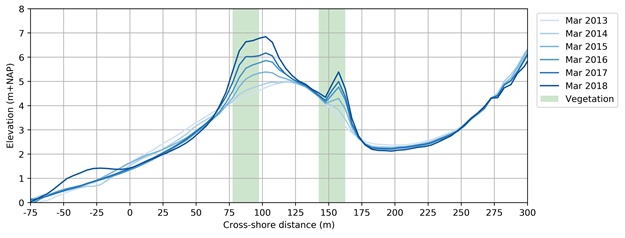J.J. Oude Vrielink1,2*, M.A. Eleveld2, B. van der Valk2, B. van Westen2, G. Hendriksen2, S.D. IJff2, F. van der Meulen3, R.C. de Zeeuw4, M.R. van Eerden5, K. Borst5, F. Galiforni-Silva1, K.M. Wijnberg1
1 University of Twente
2 Deltares
3 Van de Meulen Consultance
4 Shore Monitoring & Research
5 Rijkswaterstaat
Corresponding author:
Introduction
In 2009 a new dune-dune slack called Spanjaards Duin was constructed in front of the Delfland Coast. Spanjaards Duin was created as a compensation measure for the expected eutrophication of dune habitats due to increase in nitrogen deposition from use of the Rotterdam harbour expansion, Maasvlakte 2 (van der Meulen et al., 2014). Sediment fluxes shape the dune landscape and in doing so, affect establishment and growth of vegetation. Therefore, this study aims to identify and analyse which annual (meso-scale) sediment transport patterns develop in this engineered foredune-dune slack system.
Methods
The morphological development of the foredune-dune slack system was studied using 9 years of annual airborne LiDAR elevation data focusing on cross-shore profile evolution. Next, a process-based aeolian sediment transport model (AeoLiS) that included supply limiting processes, such as armouring (Hoonhout and de Vries, 2016), was calibrated and validated on the annual profile data set. It was used to simulate spatial patterns in aeolian sediment transport across the new foredune and in the adjacent dune slack based on one year of daily wind data. All simulated transport events were summed up to reveal how aeolian sediment transport behaved on an annual scale.
Results
The morphological analyses showed Marram grass, which had been planted in two strips along the top of the foredune, functions as a transport limiting factor and was a trigger for growth of the foredune (Figure 1). The annual-scale transport pattern derived from the simulations showed that under the prevailing wind climate this limited sediment supply to the dune slack. In addition, the dredged seabed sediment from which the area was constructed, contained shells and shell fragments leading to surface armouring in the dune slack. This limited the sediment entrainment, and hence functioned as a supply-limiting factor, which slowed down the deflation of the dune slack (Figure 1).

Figure 1. Observed evolution of alongshore-averaged elevation profiles.
References
Hoonhout, B. M. & de Vries, S. (2016). A process-based model for aeolian sediment transport and spatiotemporal varying sediment availability. Journal of Geophysical Research: Earth Surface, 121 (8), 1555-1575. doi:10.1002/2015JF003692
van der Meulen, F., van der Valk, B., Baars, L., Schoor, E. & van Woerden, H. (2014). Development of new dunes in the Dutch Delta: nature compensation and `building with nature'. Journal of Coastal Conservation, 18 (5), 505-513. doi:10.1007/s11852-014-0315-2
I. Surname1*, F.N. Another-Surname2 , Y. Next-Surname2
1 University Name, Country; 2 Organization Name, Country
* Corresponding author: mail.name@organization.org


